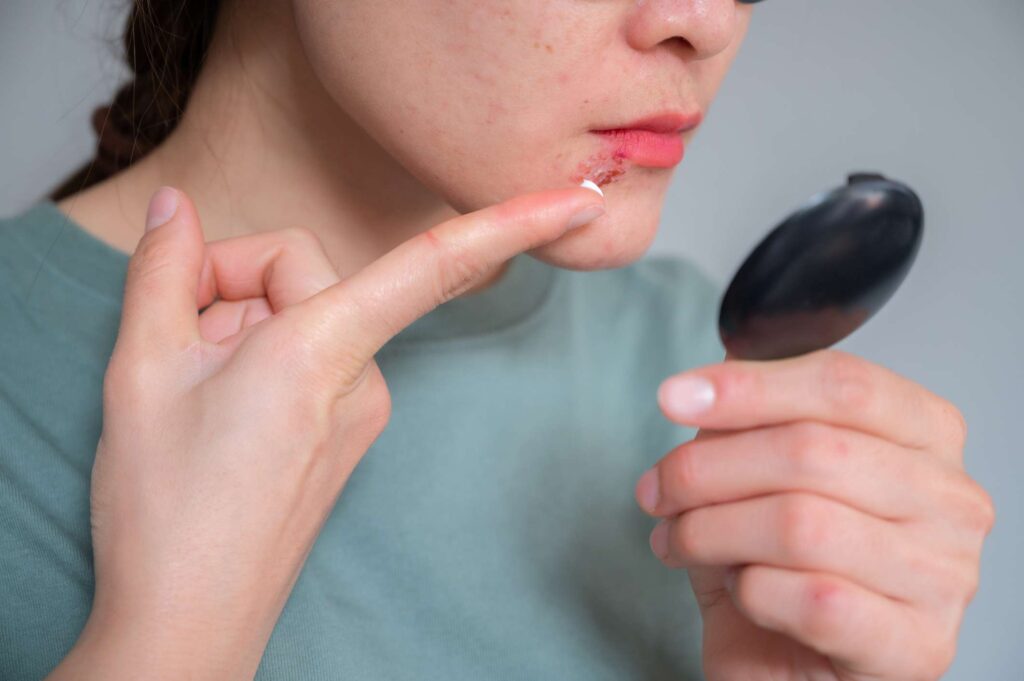:max_bytes(150000):strip_icc():format(jpeg)/Health-GettyImages-1307242693-97180719f47f4a9c87dc87d4d8e20292.jpg)
| SYMPTOMS OF COLD SORES | SYMPTOMS OF PIMPLES |
| Painful, itching, burning, or tingling skin | Red, inflamed skin |
| Tiny blisters filled with clear fluid | Tender bump with white or black oily pus |
| Scab formation | Painful cysts under the skin |
| Located around the lips and mouth | Located anywhere on the face |
Cold sores and pimples are distinct skin conditions with different causes and treatments. If you’re concerned about having either condition, knowing the difference between the two can help you better understand what you’re experiencing.
Different Causes
Cold sores are caused by the herpes simplex virus (HSV-1), a virus that is easily spread between people. Pimples are not caused by a virus but rather by bacteria.
The most common cause of pimples is increased sebum, an oily substance your skin glands produce. Sebum can clog hair follicles, causing bacteria that grow naturally on your skin to increase and cause a pimple.
Hormones can play a role in the production of sebum and the development of pimples.
Cold Sores Are Contagious
The herpes simplex virus (HSV-1) that causes cold sores is contagious and can spread to others through kissing and sharing drinks and towels.
The herpes virus is most contagious when you have a cold sore but can spread to others even when you’re asymptomatic. If you participate in oral sex while having a cold sore, you can spread the virus to your partner’s genitals.
Unlike cold sores, pimples are not contagious. The bacteria that cause pimples are present naturally on your skin.
Different Treatments
Although cold sores and pimples can look similar, their treatments are very different.
There is no cure for herpes simplex virus (HSV-1). The virus periodically becomes active and produces cold sores but usually remains inactive in your nerve cells. Your healthcare provider may prescribe an antiviral medication for cold sores, such as Valtrex (valacyclovir).
Over-the-counter (OTC) products, such as Abreva (1-Docosanol), and vitamins like L-lysine can help reduce the duration and discomfort of cold sores. If left untreated, cold sores usually resolve on their own.
Treatment for pimples is different. Your healthcare provider may prescribe an antibiotic or a retinol-based medication to help reduce the bacteria that caused your breakouts.
If you have ovaries, your provider may also prescribe hormonal birth control or testosterone blockers to reduce the production of sebum that fuels pimple-causing bacteria. There are also many OTC treatments, such as face washes, to help clean your skin.
Affect Different Body Parts
Cold sores are typically located around the mouth and lips but can spread to the eyes and genitals.
Pimples can appear on your back, shoulders, and face. They do not typically spread to the genitals and are not present in the eyes, lips, or mouth.
Cold sores and pimples can sometimes be hard to differentiate between because of a few overlapping similarities. If you’re experiencing either skin condition, you’re not alone.
Both Conditions Are Common
Cold sores and pimples are both common skin conditions affecting people of all ages. Up to 80% of adults have herpes simplex virus (HSV-1), and about 30% will have recurring cold sores.
Pimples are also common—over 85% of adolescents and older adults develop pimples. Approximately 25% of people assigned female at birth and 10% of people assigned male at birth will experience adult acne.
Similar Prevention Strategies
Although cold sores and pimples have different underlying causes, certain lifestyle changes can help prevent both conditions. Psychological stress and an unbalanced diet can increase your risk of flare-ups and breakouts.
Some steps you can take to reduce these factors and improve your overall health include:
Both Can Affect Your Mental Health
Living with skin conditions can take a toll on your mental health. The stigma around herpes can make cold sores challenging, especially if flare-ups are frequent. Pimples can be difficult to treat, and living with pimples long-term can impact your self-esteem and cause anxiety and depression.
Cold sores and pimples are completely separate skin conditions that you can have at the same time.
Although cold sores are caused by a virus and pimples by bacteria, some risk factors could exacerbate both at the same time. For example, a period of high stress could cause both an increase in pimples and a cold sore flare-up.
Distinguishing between the two conditions requires you to understand the unique symptoms associated with each, such as the location of the blemish and the presence of blisters.
Cold sores usually resolve on their own in about 1-2 weeks. A small outbreak of pimples can also be managed at home with face hygiene practices and OTC products.
If you are experiencing an increase in pain or discomfort with either condition or if the symptoms are long-lasting, speak to a healthcare provider. A primary care physician can usually diagnose and treat these conditions. They may refer you to a dermatologist (skin specialist) for specialized care.
Cold sores and pimples are common skin conditions with different causes, symptoms, and treatments.
Cold sores are caused by the herpes simplex virus (HSV-1) and typically appear as fluid-filled blisters around the mouth, often accompanied by pain or itching. They are contagious and can spread through kissing or shared items.
Pimples are caused by increased sebum production that helps bacteria grow in clogged hair follicles, leading to red, inflamed skin or cysts. They typically form on the face, back, or shoulders.
While cold sores are treated with antivirals, pimples can be managed with antibiotics, retinoids, or OTC products. Both conditions can affect mental health and may worsen due to stress, diet, and hygiene. Although they are separate conditions, it’s possible to experience both simultaneously.













